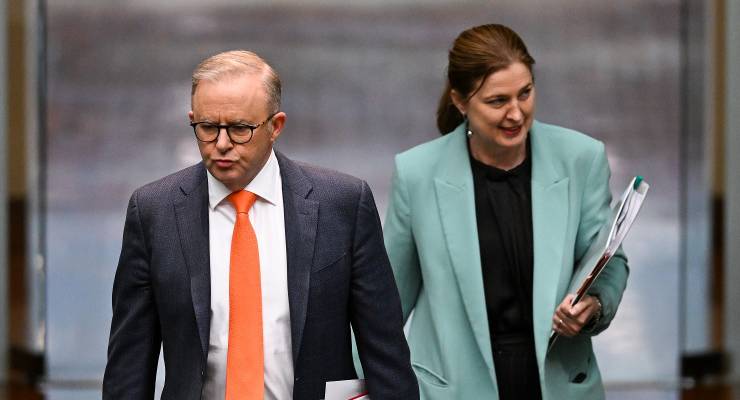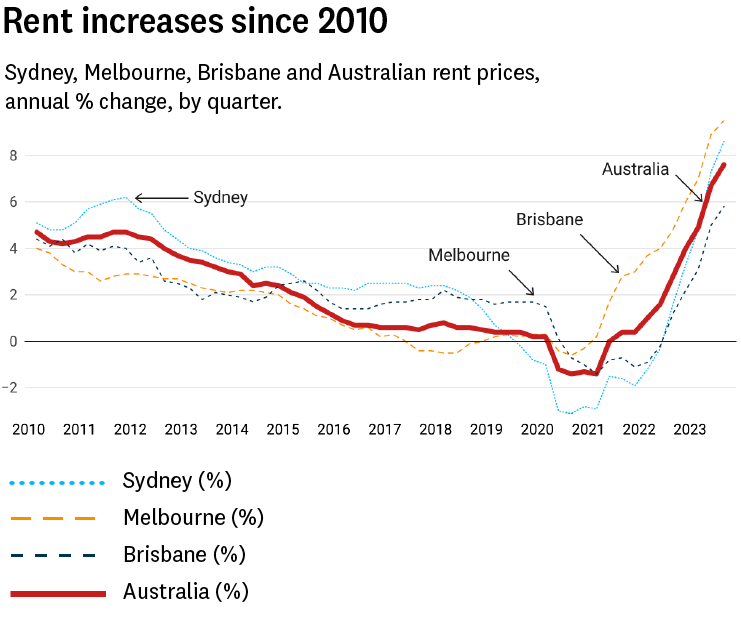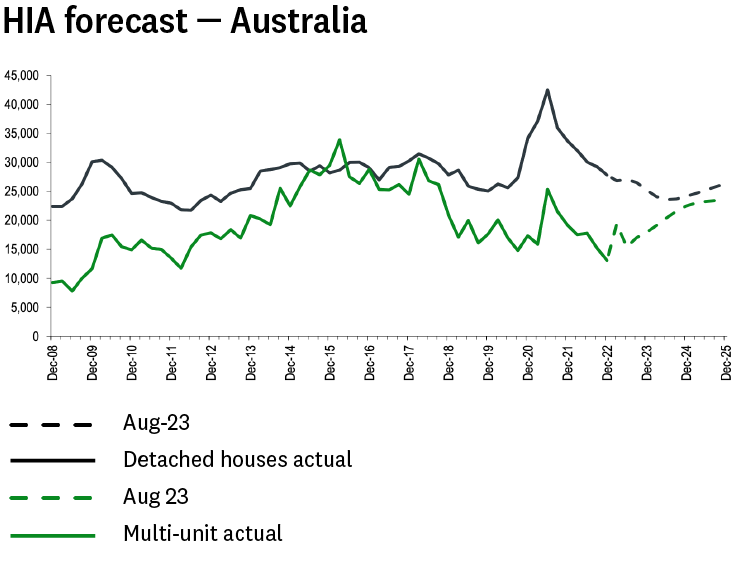
Politics seems to start up earlier and earlier every year, as Guardian Australia‘s Paul Karp noted this week. Our prime minister certainly hasn’t had much of a summer break. The year has already seen Anthony Albanese start campaigning for the Dunkley by-election, and announce he wants to give the Australian Competition and Consumer Commission more powers to discipline the supermarket duopoly.
On Monday, Albanese told the ABC’s Raf Epstein that Labor might deliver some extra cost-of-living goodies even before the May budget. On Tuesday, the prime minister was in Sydney with NSW Premier Chris Minns, spruiking a joint initiative between the state and the feds for $206 million in energy upgrades for renters and low-income households.
The focus on the cost of living reflects the difficult political terrain Labor now travels. Electoral support for the government has softened in recent months, in no small part due to voter concerns over cost of living pressures. And the biggest cost of living for most people is housing, either rent or a mortgage.
You don’t have to be a professional pollster to work out that housing is hurting Labor, especially in marginal seats in the outer suburbs. But Albanese and Housing Minister Julie Collins can at least start the year with a hard-fought policy win: Labor’s Housing Australia Future Fund (HAFF), the government’s much-debated housing investment policy for social and community housing, which opened for applications this week.
The HAFF had a difficult gestation. Its complicated architecture — creating a $10 billion public investment fund that will then dole out finance for the construction of social and affordable housing — made it a tough sell. Critics pointed out that direct investment might be simpler and more effective. The Greens made hay attacking the fund as inadequate and under-resourced, before eventually supporting an amended scheme. After bitter negotiations, Labor finally got the scheme through the Senate, at the cost of $3 billion in extra measures and a significant delay in the HAFF’s commencement.
Now that the dust has settled, the hard work begins. As might be expected, the social housing sector is excited, as the long-hoped-for investment finally flows.
The Community Housing Industry Association’s Wendy Hayhurst tells Crikey that, given the delays so far, many organisations have projects ready to go. “These projects are relatively risk-free, in the sense you don’t have to get your presales, you’re not worried about the approval process, you’re going to be able to get tenants in once they’re constructed,” she said in a phone interview. “We should be able to get bricks on the ground.”
Hayhurst wants the HAFF kitty doubled to $20 billion so it can finance more construction. “During the passage of the legislation there were a lot of people saying it would not be able to deliver the homes — I’m not one of those people, I’d like it to be far larger.” She argues that a successful HAFF will end up like the Clean Energy Finance Corporation, too risky for an incoming Coalition government to kill off. “I see it as really important to get this working really well, so it’s much harder not to continue it.”
The newly constituted federal agency, Housing Australia, has recently hinted it could start buying up existing properties on the open market, in what Housing Australia CEO Nathan Dal Bon describes as “the opportunity to undertake some spot purchases” to “pick up some surplus stock for cheaper than what it is to build at the moment”. In November, Housing Australia poured $517 million into a Victorian government social housing initiative, under its so-called “ground lease” model.
There’s plenty to do. The brunt of the housing crisis is being born by renters, who are doing it tough. Rent increases in recent years have been eye-watering. According to data from research firm CoreLogic, rents grew 8.3% in 2023. That’s on top of hikes of 9.6% in 2021 and 9.5% in 2022. On this metric, rents are up by more than a quarter in three years. Australian Bureau of Statistics (ABS) data on rents is slightly lower, at 7.6% in the September quarter, but the direction is up — and up.

The upshot is the kind of poverty porn that Jordan van den Berg’s Shit Rentals is making famous on your social media feed, as desperate renters are driven into substandard accommodation, or simply into homelessness.
The driving force for spiking rents is low vacancy rates, now below 1% in some capitals. High rent rises and very low affordability for first-home buyers are in turn at least partly a function of stagnating housing supply.
Australia is not building enough dwellings. Housing construction is in the doldrums: the latest ABS figures show housing starts for the June 2023 quarter were just 40,000, a 10-year low. Multi-unit commencements were even worse, bumping along at figures not seen since 2011-12. The apartment building boom of the mid-2010s is now a distant memory.

Housing approvals are also below the levels seen for much of the past decade and were down again in the most recent data for November. The Housing Industry Association’s Tim Reardon says that “the low volume of building approvals throughout 2023 will see the volume of homes commencing construction continue to slow this year.” Looking forward, the association thinks detached housing construction will flatline in 2024-25, while apartments will bounce back, but not to the same levels as between 2015 and 2018. In summary, housing supply will improve only slowly.
The bulk of the government’s target of 1.2 million new dwellings will have to be completed by the private sector. This leaves Albanese and Collins at the mercy of market conditions. In the short term, those conditions are pretty negative, with a string of home builders in receivership, and high interest rates suppressing private dwelling investment. While the construction supply chain problems experienced during the pandemic have stabilised, the industry currently suffers from significant skills shortages, especially in key building trades and professions.
For all of these reasons, Labor will be hoping that the HAFF can prove its critics wrong. After all, even if the HAFF can only build a fraction of the affordable homes Australia needs, the feds are at long last investing in new dwelling construction. In the medium term, the fund might also start to rebalance one of the nation’s biggest policy failures: our intensely privatised property market. Labor will need all the wins on housing it can get.
Should Labor be focusing more on housing? Let us know your thoughts by writing to letters@crikey.com.au. Please include your full name to be considered for publication. We reserve the right to edit for length and clarity.








I’d counter that the Greens were not making hay in attacking the govt Re: HAFF, given that are soley responsible for the direct funding that it now includes. Making hay suggests that it was purely political point scoring, they got actual tangible outcomes.
Hayhurst was v critical of the Greens at the time, insisting that HAFF should be waived through as is.
They got SFA.
If they were serious they would have demanded the Govt direct the RBA to “print” 10B a year for 10 years and create an equity housing fund that would have pumped out money and houses forever. But because the Greens attacked the core policy mechanism of using the profits from the investments to fund housing construction they couldn’t do squat with making it actually a better fund. It was just basic MMT – which you’d think the Greens would be leading the debate on. These borrowing are all off budget, and when managed properly like the Future Fund are excellent long term investment vehicles for governments. Moreover, the LNP has been doing these sovereign wealth funds for years. It can still be improved like I’ve suggested – but a sensible debate was poisoned by the Greens and Libs as per usual and Labor won’t go near any of this again for years.
The Greens attacked the fact it wasn’t going to build [m]any houses.
$10b spent on building or buying existing houses for public housing would have been enthusiastically waved through.
I don’t think you’d find many MMTers who advocate Government expenditure be funded from the profits of a portfolio.
Soften the change by grandfathering it to new housing investment.
Stop overseas investment (money laundering) in local housing (finally)
Overall tax reform
Stop immigration until the population stabilise back to what the infrastructure was planned for.
Overall tax reform
Stop pretending the increasing weather effects due to climate change can be ignored.
Stopping ‘immigration’ will have little impact as <190K new permanent migrants are onshore already, but nativist MSM focuses on short term ‘noise’ due to high NOM temporary OS migrant churn (impacted by Covid), dominated by students of whom the majority are not ‘immigrants’ as they will depart; confusing terminology since the noughties.
As explained by Hans Rosling globally, the growth in populations is the outcome of previous generations’ high fertility i.e. aggregation or cumulation, not high fertility nowadays; locally long term permanent driver is our ageing population i.e. 60-70 years+.
You are being dishonest, as usual.
NOM is a net number (it’s right there in the name). That means when NOM is, say, 400k next year, it will mean 400k additional people are in the country compared to the year before. It does not mean – as you like to imply with terms like “churnover”, “temporary” and “not immigrants” – 400k people left and were replaced by a different 400k.
The end result of 400k NOM is that 400k more people need somewhere to sleep, and all the additional supporting infrastructure involved with living in Australia.
Kudos @drsmithy for your persistence.
Agree, with fast direct investment by the government or related into social/public housing and loosened zoning for more high density &/or micro (esp. regions) vs. tinkering on the edges to preserve house prices…..
By the nature of the perverse incentives for negative gearing etc. for property investors to lose money, suggests that Howard et al. knew the demographic future (like Hawke/Keating knew on super), that is a heaving mass of retirees i.e. boomer ‘bomb’ and oldies dominant in house equity then holding same longer due to improved health and longevity; hardly rocket science, but ignored.
And not a word about the runaway immigration.
An insult to intelligence.
Colour me unsurprised.
What is the government doing about housing? As little as possible. A lot of smoke and mirrors. A lot of wishful thinking and the power of hope. They are not prepared to fund State and Territory governments to invest in public housing. Therefore more poorer and vulnerable tenants and people will be in inequitable and insecure private renting. There needs to be double the people in social housing broadly. The government and in fact all governments federally and State and territory, don’t want to spend a dime on social housing. They want the market to sort everything out or get social housing, more really, not-for-profit housing schemes, to take up the slack.
“..Labor will be hoping that the HAFF can prove its critics wrong.” HaHaHa…LOL…except it’s such a sick joke. A fig leaf trying to cover up a monstrous and growing crisis, and the betrayal of our younger generations.
This failure alone will condemn Labor to minority government in 2025, and they will richly deserve it.